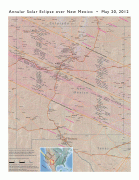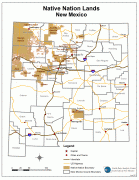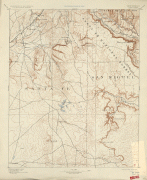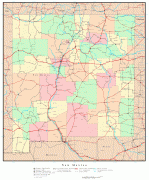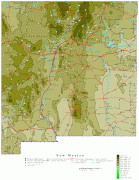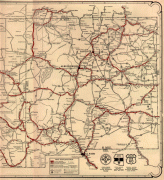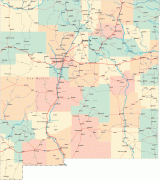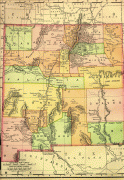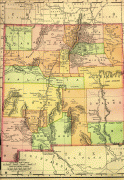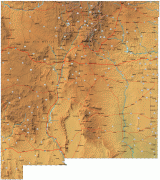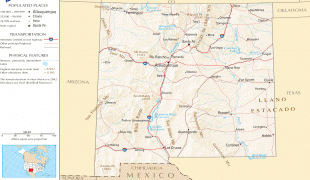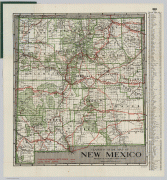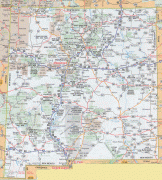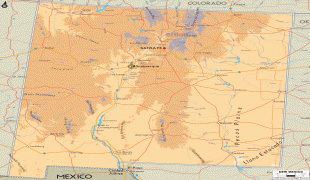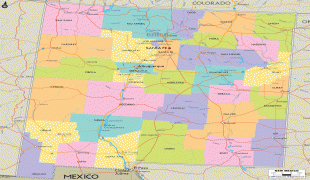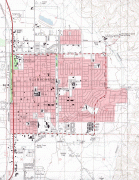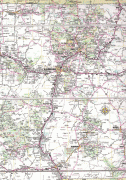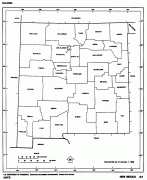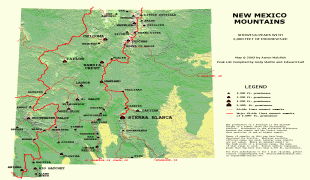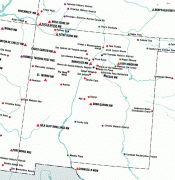New Mexico (New Mexico)
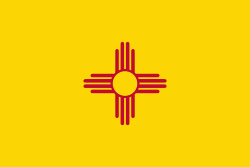 |
 |
New Mexico is the fifth-largest of the fifty states, but with just over 2.1 million residents, ranks 36th in population and 46th in population density. Its climate and geography are highly varied, ranging from forested mountains to sparse deserts; the northern and eastern regions exhibit a colder alpine climate, while the west and south are warmer and more arid. The Rio Grande and its fertile valley runs from north-to-south, creating a riparian climate through the center of the state that supports a bosque habitat and distinct Albuquerque Basin climate. One–third of New Mexico's land is federally owned, and the state hosts many protected wilderness areas and national monuments, including three UNESCO World Heritage Sites, the most of any state.
New Mexico's economy is highly diversified, including cattle ranching, agriculture, lumber, scientific and technological research, tourism, and the arts, especially textiles and visual arts. The state has significant sectors in mining, oil and gas, aerospace, media, and film. Its total gross domestic product (GDP) in 2020 was $95.73 billion, with a GDP per capita of roughly $46,300. State tax policy is characterized by low to moderate taxation of resident personal income by national standards, with tax credits, exemptions, and special considerations for military personnel and favorable industries. Due to its large area and economic climate, New Mexico has a significant U.S. military presence, including White Sands Missile Range, and strategically valuable federal research centers, such as Sandia and Los Alamos National Laboratories. The state hosted several key facilities of the Manhattan Project, which developed the world's first atomic bomb, and was the site of the first nuclear test, Trinity.
In prehistoric times, New Mexico was home to Ancestral Puebloans, Mogollon, as well as ancestors of the Comanche and Ute people. Navajos and Apaches entered the state towards the end of the 15th century. Spanish explorers and settlers arrived in the 16th century from present-day Mexico, naming the territory Nuevo México after the Aztec legends about the Pueblos of Yancuic Mexihco, a new Mexico, which evolved into the stories of the Seven Cities of Gold. Isolated by its rugged terrain and the relative dominance of its indigenous people, New Mexico was a peripheral part of the viceroyalty of New Spain. Following Mexican independence in 1821, it became an autonomous region of Mexico, albeit increasingly threatened by the centralizing policies of the Mexican government, culminating in the Revolt of 1837; at the same time, the region became more economically dependent on the United States. At the conclusion of the Mexican–American War in 1848, the U.S. annexed New Mexico as part of the larger New Mexico Territory. It played a central role in U.S. westward expansion and was admitted to the Union as the 47th state on January 6, 1912.
New Mexico's history has contributed to its unique demographic and cultural character. One of only six majority-minority states, it has the nation's highest percentage of Hispanic and Latino Americans and the second-highest percentage of Native Americans after Alaska. New Mexico is home to part of the Navajo Nation, 19 federally recognized Pueblo communities, and three different federally recognized Apache tribes. Its large Hispanic population includes Hispanos, who descend from Oasisamerican groups and settlers of Nuevo México in New Spain, as well as later groups of Mexican Americans since the 19th century. The New Mexican flag, which is among the most recognizable in the U.S., reflects the state's eclectic origins, bearing the scarlet and gold coloration of the Spanish flag along with the ancient sun symbol of the Zia, a Puebloan tribe. The confluence of indigenous, Hispanic (Spanish and Mexican), and American influences is also evident in New Mexico's unique cuisine, music genre, and architectural styles.
New Mexico received its name long before the present-day nation of Mexico won independence from Spain and adopted that name in 1821. The name "Mexico" derives from Nahuatl and originally referred to the heartland of the Mexica, the rulers of the Aztec Empire, in the Valley of Mexico. The Classical Nahuatl term Yancuic Mexihco, a new Mexico, was used to describe a mystical empire that rivaled the scale of their own Aztec Empire. These myths had a basis in the trade network of the Pueblos. These stories eventually evolved into the folklore of the Seven Cities of Gold.
Following their conquest of the Aztecs in the early 16th century, the Spanish began exploring what is now the Southwestern United States calling it Nuevo México, a Spanish language translation of the prior Nahuatl term Yancuic Mexihco. In 1581, the Chamuscado and Rodríguez Expedition named the region north of the Rio Grande San Felipe del Nuevo México. The Spaniards had hoped to find wealthy indigenous cultures similar to the Mexica. The indigenous cultures of New Mexico, however, proved to be unrelated to the Mexica and lacking in riches, but the name persisted.
Before statehood in 1912, the name "New Mexico" loosely applied to various configurations of territories in the same general area, which evolved throughout the Spanish, Mexican, and U.S. periods, but typically encompassed most of present-day New Mexico along with sections of neighboring states.
Map - New Mexico (New Mexico)
Map
Country - United_States
 |
 |
| Flag of the United States | |
Indigenous peoples have inhabited the Americas for thousands of years. Beginning in 1607, British colonization led to the establishment of the Thirteen Colonies in what is now the Eastern United States. They quarreled with the British Crown over taxation and political representation, leading to the American Revolution and proceeding Revolutionary War. The United States declared independence on July 4, 1776, becoming the first nation-state founded on Enlightenment principles of unalienable natural rights, consent of the governed, and liberal democracy. The country began expanding across North America, spanning the continent by 1848. Sectional division surrounding slavery in the Southern United States led to the secession of the Confederate States of America, which fought the remaining states of the Union during the American Civil War (1861–1865). With the Union's victory and preservation, slavery was abolished nationally by the Thirteenth Amendment.
Currency / Language
| ISO | Currency | Symbol | Significant figures |
|---|---|---|---|
| USD | United States dollar | $ | 2 |
| ISO | Language |
|---|---|
| EN | English language |
| FR | French language |
| ES | Spanish language |






